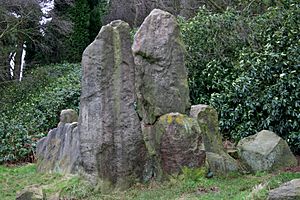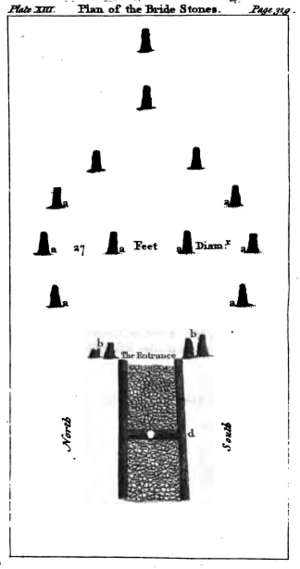The Bridestones facts for kids
 |
|
| Location | near Congleton |
|---|---|
| Region | Cheshire, England |
| Coordinates | 53°9′24.64″N 2°8′31.3″W / 53.1568444°N 2.142028°W |
| Type | Chambered cairn |
| History | |
| Periods | Neolithic |
| Site notes | |
| Condition | damaged |
The Bridestones are ancient stone structures located near Congleton in Cheshire, England. These stones are part of a special type of burial mound called a chambered cairn. People built them during the Neolithic period, which was a very long time ago, between 3500 and 2400 BC.
When the Bridestones were first built, they were much bigger. In 1764, people described the whole structure as being about 120 yards (110 meters) long and 12 yards (11 meters) wide. It had three separate rooms or compartments inside. Today, only one of these rooms remains. This remaining room is about 6 meters (20 feet) long and 2.7 meters (9 feet) wide. It is made of tall, upright stone slabs. A stone slab used to divide this room, but it is now broken.
Originally, a circle of stones surrounded the cairn. There were also four special "portal stones" that marked an entrance. Only two of these portal stones are still standing today. The Bridestones site is very important, so it is protected as a scheduled ancient monument. This means it's a special historical place that must be preserved.
Contents
Discovering The Bridestones
What They Looked Like Long Ago
We know a lot about how the Bridestones looked in the 1700s. A detailed report was written in 1766 by Rev. Thomas Malbon. This report was included in a book called Mona Antiqua Restaurata by Henry Rowlands. The report was written because many stones were being taken away in 1764. These stones were used to build a new road nearby. This road is now called Dial Lane.
The report described the site in great detail. It mentioned six large, upright stones that formed a semicircle. These stones were different sizes and shapes. People thought there might have been a full circle of stones originally. The ground inside this circle was very dark. It had ashes and pieces of oak wood charcoal. This suggests fires were made there.
The report also talked about a special "cave" or chamber. The floor of this cave was made of flat, broken stones. These stones were laid on top of crushed white stones. The top part of the crushed stones was black, probably from ashes falling through the floor. Small pieces of bone were found here too. It was hard to tell if they were human bones or not.
The sides of this main chamber were once two very long, unshaped stones. Each stone was about 18 feet (5.5 meters) long and 6 feet (1.8 meters) tall. Now, both of these large stones are broken into two pieces. There was also a stone partition inside the chamber. This stone had a round hole cut through it. The whole chamber was covered with large, flat stones, but these are now gone.
The entrance to the chamber was filled with stones and earth. People thought this was dust blown in by the wind over many years. The report also mentioned another smaller chamber. It was about 55 yards (50 meters) away from the main one. There was also a huge pile of stones that covered the entire site. This pile was 120 yards (110 meters) long and 12 yards (11 meters) wide.
Stories Behind the Name
The name "Bridestones" is a bit of a mystery. No one is completely sure how the cairn got its name. There are a few interesting ideas:
- One old story says that a newly married couple was killed at this spot. The stones were then placed around their grave.
- Another idea is that the stones are named after a goddess called Brigantia. She was an important goddess in ancient times.
- A third possibility comes from the Old English word for "birds," which was "briddes." Perhaps the stones, in their original shape, looked like birds. This could have led to the name "Briddes stones."
How The Stones Changed Over Time
What Happened to the Stones
Over the years, many stones from the Bridestones monument were taken away. The biggest removal happened when hundreds of tons of stone were used to build the nearby turnpike road. Stones were also taken to build a house and a farm nearby. Some stones even ended up in an ornamental garden at Tunstall Park.
One of the most famous stones, the "holed stone" (the one with the circular hole), was broken before 1854. The top part of it was found and put back in 1877. However, it was gone again by 1935.
The southern side of the main chamber was originally one very long stone, about 18 feet (5.5 meters) long. But in 1843, it split into two pieces. This happened because some picnickers built a bonfire too close to it. Of the original portal stones, only two are left. One of them is broken and has been put back together with concrete. People say this damage was caused by an engineer from the Manchester Ship Canal. He supposedly used the stone to show how a detonator worked.
Fixing the Site
In 1936 and 1937, Professor Fleur from Manchester University led excavations at the site. The goal of these digs was to learn more about the Bridestones. They also wanted to try and restore the site as much as possible to how it looked in the past.



